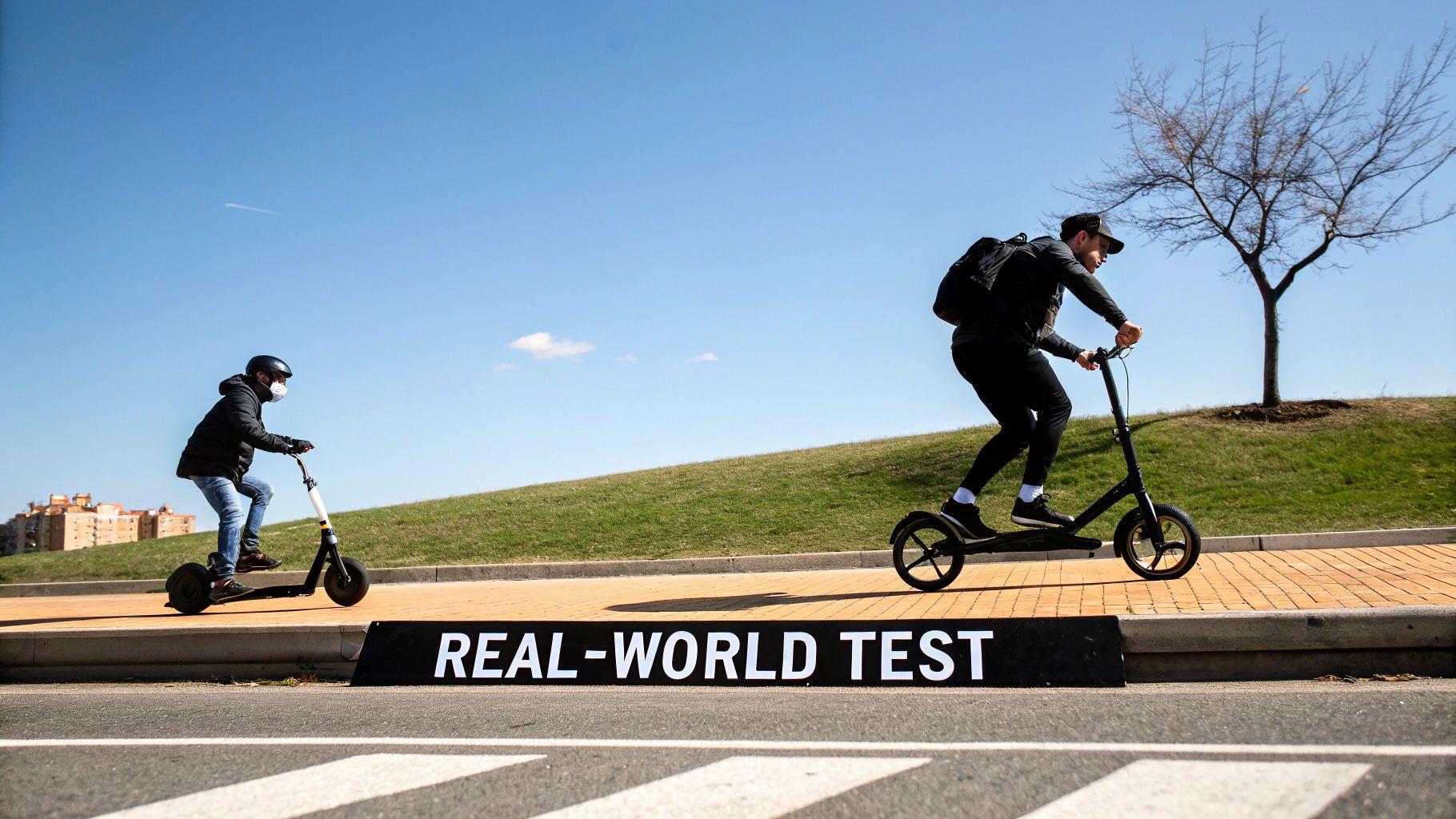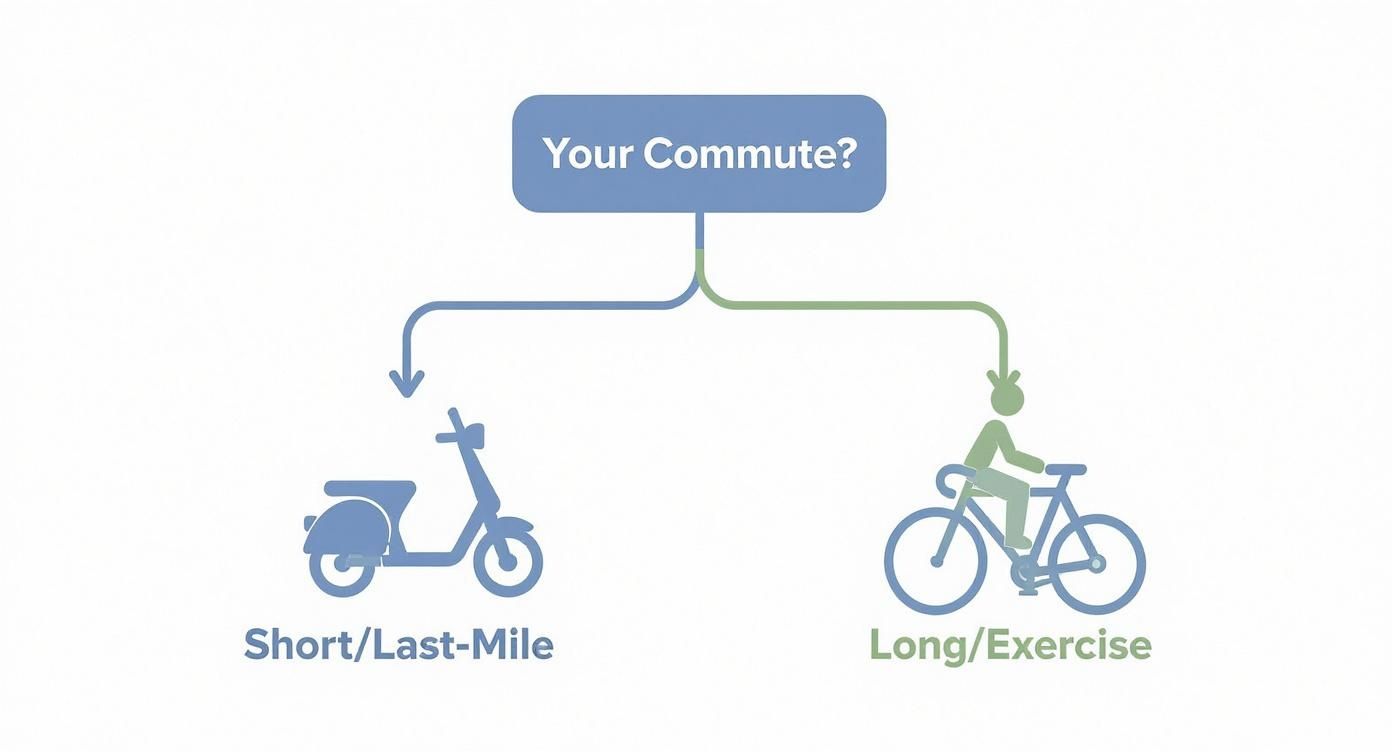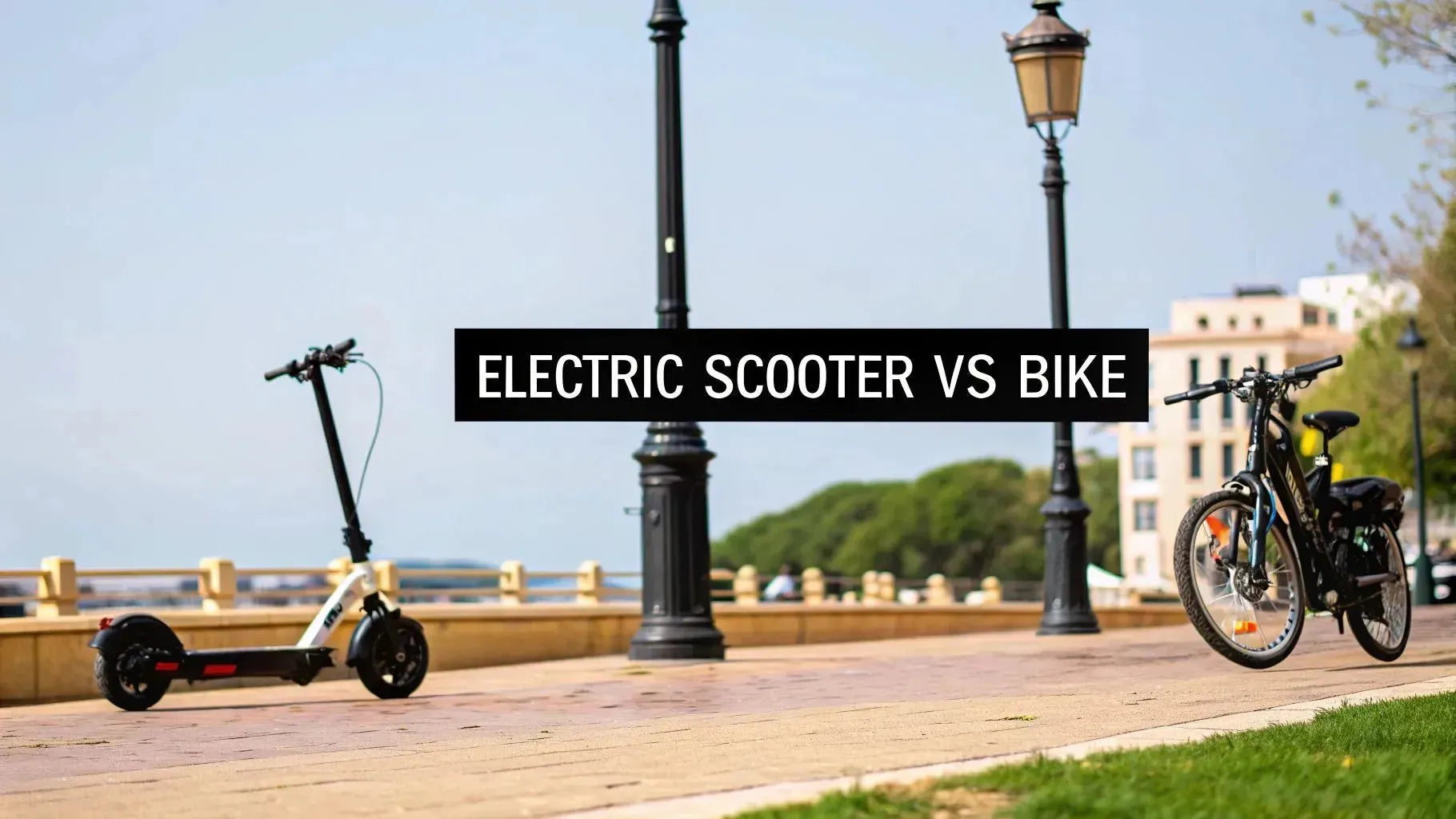The fundamental difference is pretty simple: e-scooters are all about ultimate portability and a zippy, effortless ride. On the other side, e-bikes deliver way more comfort, a longer range, and the power to crush hills. It really comes down to what you value most: grab-and-go convenience for quick trips, or a more solid, fitness-friendly ride for longer hauls.
Your Quick Guide to Choosing an Urban Ride

Trying to pick between an e-scooter and an e-bike can feel like a tough call. But honestly, it all boils down to how you see yourself getting around town. Each one has its own vibe and is built for different kinds of trips, distances, and importantly, different local laws—especially here in the US and across Australia.
The e-scooter has completely taken over as a city staple. You can see it in the numbers; the global e-scooter market was worth around $17.73 billion in 2023 and is expected to blow up to $50.15 billion by 2032. That explosion in popularity tells you everything you need to know about how perfect they are for that "last mile" from the train station or for short, spontaneous trips. You can dive deeper into the e-scooter market trends over at NimbleAppgenie.
Then you have the e-bike. It’s built on a design we all know and trust, giving you a much more stable and comfortable ride that’s just better for longer distances and bumpy city streets. Plus, it gives you the option to get a bit of light exercise in, which is a huge bonus for a lot of commuters.
This isn't just about comparing specs on a page; it's a lifestyle choice. The e-scooter is perfect for a fast-paced, stop-and-go urban rhythm. The e-bike, on the other hand, is for the steady commuter who puts a premium on comfort and versatility.
To make things crystal clear, let's get into what really separates them.
E-Scooter vs E-Bike At a Glance
Sometimes you just need to see the core differences side-by-side. This table cuts through the noise and gives you a quick snapshot of what matters most when you're weighing an e-scooter against an e-bike.
| Feature | Electric Scooter | Electric Bicycle |
|---|---|---|
| Best For | Short commutes, last-mile travel, maximum portability | Longer commutes, exercise, varied terrain, comfort |
| Portability | Excellent; often lightweight and foldable | Fair to Poor; heavier and bulkier, requires more space |
| Comfort | Fair; standing posture, smaller wheels feel bumps | Excellent; seated position, larger wheels, often has suspension |
| Range | Typically 10-30 miles | Generally 25-50+ miles (pedal-assist extends range) |
| Hill Climbing | Fair; can struggle on steep inclines | Excellent; pedal-assist provides strong torque for hills |
| US/AU Legality | Generally legal, but with state/city-specific rules | Widely legal, often with a class system (US) or power limits (AU) |
As you can see, there’s no single "best" option—it all depends on your specific needs and how you plan to ride. Think of this table as your starting point for figuring out which one slots perfectly into your daily life.
Comparing Real-World Performance and Practicality

When you're trying to pick between an electric scooter and an electric bike, the numbers on a spec sheet are just the beginning. The real story unfolds on your actual commute—that surprise hill, the pothole-riddled side street, and how it all fits into your daily grind. This is where the practical differences in range, speed, and portability really hit home.
Range is usually the first thing people worry about. For an e-scooter, the battery is everything, with most models giving you a real-world range of 10 to 30 miles (16 to 48 km). That's usually more than enough for short city trips or that last-mile jump from the train station. But keep in mind, things like your weight, hilly terrain, and even cold weather can eat into that number. We break down how to get the most out of every charge in our guide to understanding electric scooter range.
When it comes to distance, e-bikes almost always take the crown. With a typical range of 25 to 50+ miles (40 to 80+ km), they’re built for longer hauls. The secret sauce is pedal-assist; by pitching in with your own leg power, you save a ton of battery, turning what might feel like a daunting 10-mile ride into a total breeze.
Acceleration, Speed, and Handling City Streets
While both can reach similar speeds, regulations in the US and Australia often allow for higher top speeds than in Europe. E-bikes in the US are categorized into classes, with Class 3 models assisting up to 28 mph (45 km/h). E-scooter speed limits vary widely by state, often capping around 15-20 mph (25-32 km/h).
E-scooters give you that instant, zippy acceleration right from the throttle. It’s perfect for pulling away from a red light and weaving through stop-and-go traffic.
E-bikes, on the other hand, deliver a more gradual, powerful acceleration that feels solid and controlled. Thanks to their bigger wheels and (usually) better suspension, they handle rough patches, cobblestones, and curbs with way more confidence than an e-scooter’s small, solid tires ever could.
An e-scooter feels like a speedboat—quick, agile, and perfect for smooth water. An e-bike is more like a sturdy cruiser, handling choppy waves with confidence and making the overall journey much more comfortable.
This difference in handling is a huge deal on less-than-perfect city streets. If you're on a scooter, you have to stay sharp, because a small pothole can feel like a crater. An e-bike rider, however, can just cruise over most of those bumps without a second thought, which makes for a much more relaxed ride.
Portability and Day-to-Day Convenience
Practicality isn't just about the ride itself—it's about what you do when you get to your destination. And this is where the e-scooter really shines.
- Ultimate Portability: Most e-scooters fold down in seconds. They’re light (26-40 lbs / 12-18 kg on average), making them easy to carry up to your apartment, slide under your desk at work, or bring onto the train.
- The E-Bike Challenge: E-bikes are just plain heavier (44-66 lbs / 20-30 kg or more) and a lot bulkier. Folding models exist, but even they are clunky next to a scooter. Storing one usually means you need a garage, a shed, or at least a secure spot on the ground floor.
For city dwellers, this portability factor is a massive piece of the electric scooter vs electric bicycle puzzle. If you live in a small apartment without easy ground-floor access, the daily hassle of lugging an e-bike can quickly cancel out its benefits.
While e-scooters have blown up recently, e-bikes have steadily built a massive, loyal following. The global electric bike market was valued at $33.34 billion in 2025 and is expected to climb to $40.59 billion by 2030. This just goes to show how established they are as a reliable way to get around. You can explore more e-bike market insights on Statista.com.
At the end of the day, it’s a trade-off. You're choosing between the grab-and-go convenience of an e-scooter and the superior range, comfort, and all-terrain chops of an e-bike.
US and Australian Rules: Know Before You Ride
Okay, let's talk about the elephant in the room. When you're weighing an electric scooter vs. an electric bicycle, things like speed and portability are important. But honestly, the legal side of things can make the decision for you, especially in the US and Australia where rules can be a confusing patchwork. Getting this wrong isn't just a slap on the wrist; it can mean hefty fines or even watching your shiny new ride get hauled away.
In the United States, there's no single federal law for e-bikes and e-scooters. Instead, states and even cities set their own rules. For e-bikes, many states use a three-class system:
- Class 1: Pedal-assist only, up to 20 mph.
- Class 2: Throttle-assisted, up to 20 mph.
- Class 3: Pedal-assist only, up to 28 mph.
E-scooter laws are even more varied. States like California have clear guidelines (e.g., must have a driver's license, stay in bike lanes), while others are still figuring things out. The key takeaway is to always check your specific state and city regulations.
The bottom line for US & Australian riders is simple: legality is local. An e-bike's status is often clearly defined, but you need to know which class is allowed where. For e-scooters, you must check city ordinances on speed, helmet use, and where you're allowed to ride.
This single point is often the deciding factor. If you want to dig deeper into the specifics, our guide explains in detail why electric scooters are not street legal in some jurisdictions.
Australia's State-by-State Approach
Down under, Australia also has a patchwork of state and territory laws. Generally, e-bikes are legal nationwide as long as they are "pedalecs" with a motor of 250 watts or less that cuts out at 25 km/h (15.5 mph). Anything more powerful is considered a motorbike and requires registration and a license.
E-scooter laws have been evolving rapidly. Initially banned on public roads in many places, states like Queensland, Victoria, and Western Australia now have regulated schemes and trials allowing private e-scooter use with specific rules:
- Speed Limits: Often capped at 25 km/h on paths and roads, and 10-12 km/h on footpaths.
- Helmet Laws: Helmets are almost universally mandatory.
- Location Rules: You can typically ride on bike paths and local roads (with speed limits of 50 km/h or less), but not on major roadways.
This "patchwork" approach means you absolutely have to do your homework and check the local laws for your state or territory. An e-bike, by contrast, gives you a much more consistent and predictable legal experience across the country.
Legal Requirements Snapshot US & Australia
To cut through the confusion, we've put together a quick table comparing the general state of play. Just remember, laws can change, so always double-check the latest local rules before you head out.
| Legal Aspect | E-Scooters (US/AU General Trend) | E-Bikes (US/AU General Trend) |
|---|---|---|
| Public Road Use | Legal, but highly regulated by state/city | Widely Legal |
| License Required | Varies (e.g., driver's license in CA) | Generally No |
| Insurance | Generally No (but recommended) | No |
| Helmet | Varies by age/state (often mandatory in AU) | Varies by age/state (often mandatory in AU) |
So, when it comes to the law, e-bikes often offer a clearer, more consistent path to legal riding in both the US and Australia. E-scooters provide fantastic convenience but require you to be much more diligent about checking local ordinances to stay on the right side of the law.
How You'll Feel: Comfort, Health, and Safety

Let’s talk about the real-world feel of these rides. This is a huge piece of the electric scooter vs electric bicycle puzzle. It’s not just about getting from point A to B—it’s about arriving comfortably, safely, and maybe even getting a bit of a workout. The designs here are worlds apart, and that directly shapes your daily experience.
An e-scooter has you standing tall. This is fantastic for short, zippy trips where you need to be nimble and hyper-aware of your surroundings. But ride for more than 15 minutes, and you'll start to feel it. That standing posture can lead to fatigue in your legs, back, and feet, especially if the pavement isn't perfectly smooth.
An e-bike, on the other hand, offers the familiar comfort of a saddle. This seated position spreads your weight evenly across the seat, handlebars, and pedals, making it a much better setup for longer journeys. Being able to sit down means less strain on your joints, turning a 5-mile trip from a physical chore into a pleasant cruise.
Bumps in the Road: Ride Quality and Your Joints
The physical impact of your ride comes down to two things: wheel size and suspension. E-scooters typically have small, solid wheels, usually around 8-10 inches. They're great on fresh asphalt, but they will make you feel every single crack, manhole cover, and stray pebble. Even on premium models with suspension, the fundamental design makes for a bumpier ride on rough city streets.
E-bikes, with their much larger wheels (often 26 inches or more), simply roll over those same imperfections with ease. The bigger diameter gives them a natural stability and smoothness. Combine that with the front suspension forks found on most models, and you get a ride that soaks up the shocks of urban terrain. Your back and wrists will thank you.
For a quick 2-mile dash to the train station, an e-scooter’s stand-up posture is perfectly fine. But for a 30-minute commute across town with varied road quality, the seated comfort of an e-bike is undeniably better for your long-term joint health.
This ergonomic difference is a massive deal. If your route is short and glassy-smooth, a scooter works. If you're dealing with potholes, cobblestones, or just a ride longer than 15-20 minutes, an e-bike will be a far more enjoyable and less fatiguing experience.
Health Benefits: Active Boost vs. Passive Glide
When it comes to health, it's not really a fair fight. Riding an e-scooter is a mostly passive activity. You stand, you hit the throttle, and you glide. Sure, it takes balance and some core strength, but it’s not giving you a cardiovascular workout.
The e-bike, however, is an incredible tool for sneaking exercise into your day. The pedal-assist system doesn't do all the work for you; it just gives your own effort a boost. You're still pedaling, getting your heart rate up, and working major muscle groups, but without the intense strain of a regular bike, especially on hills. It’s the perfect compromise for someone who wants the health benefits of cycling without showing up to work drenched in sweat.
On-Road Presence: Visibility and Safety
Finally, let's talk about staying safe out there. The physical profile of each ride creates a different dynamic on the road.
- Stability: An e-bike's low center of gravity and large wheels make it fundamentally more stable, especially when you need to brake hard or corner at speed. The small wheels on an e-scooter can be twitchy and are more likely to get caught in potholes or tram tracks.
- Stopping Power: E-bikes are often equipped with powerful disc brakes—the same kind you'd find on a mountain bike—giving you serious, reliable stopping power. While good e-scooters have effective brakes, your standing position can make a sudden emergency stop feel a lot less controlled.
- Visibility to Drivers: This one is critical. On an e-bike, you present a larger, more familiar silhouette to drivers. You sit higher and have a wider profile, making you easier to see in traffic. A scooter rider is lower and slimmer, which can sometimes make them harder for motorists to spot in a quick glance.
Ultimately, you need to ride defensively on either vehicle. But the basic physics of an e-bike generally give you a more stable and visible presence on the road.
What's the Real Cost of Owning One?
When you’re stuck in the electric scooter vs. electric bicycle debate, it's tempting to just look at the price tag. But that initial spend is only the beginning of the story. The true cost of ownership is a long-term game, factoring in everything from routine maintenance and surprise repairs to the inevitable day you'll need a new battery.
At first glance, e-scooters seem like the budget-friendly winner. You can grab an entry-level model for a lot less than most e-bikes, which makes them super appealing if you just want a cheap and easy way to zip around. But don't be fooled—high-performance scooters can easily cost as much, if not more, than a solid commuter e-bike.
It's the same story with e-bikes, which have a massive price range. A basic model might have a higher starting price than a scooter, but top-tier e-bikes with all the bells and whistles are a serious investment. The trick is to compare rides with similar specs to get a fair picture of the initial price gap.
Maintenance and Repairs: Where the Paths Split
This is where the real financial differences between e-scooters and e-bikes start to show. Thanks to their familiar bike DNA, e-bikes have a massive leg up when it comes to getting them serviced.
You can walk into almost any local bike shop for help with an e-bike. Need your brakes tweaked, a new chain, or your gears tuned up? The parts are common and the mechanics know exactly what to do. This makes everyday maintenance simple and relatively cheap.
E-scooters are a different beast. Their specialized components—solid tires, thumb throttles, and unique braking systems—often demand a specialist's touch. Your local bike guy probably won't know how to fix a fried motor controller, which means you could be looking at a longer wait time and a steeper bill from a dedicated e-scooter shop.
An e-bike is like a Ford or a Toyota; you can find parts and a mechanic on any corner. An e-scooter is more like a niche import; you might have to search for someone who knows what they're doing, and that can really add up over time.
You can see this playing out in the market itself. The global electric bikes and scooters market is valued at $30.27 billion in 2025 and is expected to climb to $39.1 billion by 2029. While scooters are growing a bit faster, the steady, reliable growth of e-bikes says a lot about their durability and ease of maintenance. You can dig into more on the personal electric vehicle market growth if you're curious.
The Elephant in the Room: Battery Replacement
The battery is the heart of any electric ride, and it's also the single most expensive part you'll ever replace. Both e-scooter and e-bike batteries have a limited lifespan, usually around 3 to 5 years or 500 to 1,000 charge cycles, depending on how you use and care for them.
When that day comes, get your wallet ready. Here’s a rough idea of what you can expect to pay:
- E-Scooter Battery: A new one will likely set you back $200 to $500, depending on the brand and capacity.
- E-Bike Battery: E-bike batteries are bigger and beefier, so replacements typically fall in the $400 to $800 range, and sometimes more.
While the e-bike battery costs more, the bike itself is built to last much longer, with a sturdier frame and parts that are easy to swap out. For many riders, that higher battery cost is a fair trade-off for a vehicle that will stick with them for years. If you're still on the fence about the numbers, our guide on whether electric bikes are worth it breaks it all down.
So, while an e-scooter might look cheaper on day one, the e-bike often wins the long-term financial race thanks to its superior durability and far easier maintenance.
So, Which One Is Right For You?
The whole electric scooter vs. electric bicycle debate really boils down to one simple question: which one fits your life? It's not about which is universally "better," but which one solves your specific problems. Forget the specs for a second and think about your daily grind, your commute, and what you really need from a set of wheels.
Let's get practical. Imagine you're a student crammed into a tiny city apartment in Sydney, constantly hopping on and off the train. An e-scooter is your new best friend. Its biggest advantage is its sheer portability. Fold it, carry it, tuck it under a desk—no sweat. It's the perfect tool for zipping from the station to your final stop.
Now, picture a professional with a 5-mile commute across a sprawling city like Los Angeles. For them, an e-bike is a no-brainer. You're sitting down, which is a game-changer for comfort over longer distances, and those bigger wheels just eat up potholes and rough patches in the road. Plus, you get a bit of a workout with pedal-assist without showing up to your first meeting drenched in sweat.
Match Your Ride to Your Routine
The best way to decide is to look at your actual day-to-day life. Let’s walk through a few common scenarios and see how each ride stacks up.
- Quick Errands: Need to pop down to the corner shop or grab a coffee? The e-scooter is king here. It’s a true grab-and-go machine, saving you the hassle of finding a place to lock up a bigger bike for a five-minute stop.
- Weekend Cruising: If your idea of a good time is exploring scenic paths or taking a long, leisurely ride through the park, an e-bike is the only way to go. The comfort, longer range, and ability to handle different terrains make it built for recreation.
- The Weekly Shop: Trying to haul groceries on an e-scooter is a recipe for disaster. An e-bike, on the other hand, can easily be fitted with racks and panniers, making it a surprisingly practical vehicle for carrying your shopping or a backpack with a laptop.
Ultimately, you have to ask yourself: Do I need a quick-and-dirty tool for short, spontaneous trips, or a dependable partner for longer, planned-out journeys? An e-scooter is a scalpel—precise and fast for a specific job. An e-bike is more like a Swiss Army knife—versatile and ready for anything.
A Quick Word on Your Local Area
While the core advice here holds true everywhere, the sprawling nature of many US and Aussie cities means longer commutes are the norm. In that context, the superior range and comfort of an electric bicycle often win out, making it the go-to choice for the daily trek to work. However, in dense urban cores like Melbourne's CBD or downtown San Francisco, the e-scooter's unmatched portability can easily make it the more practical choice for navigating crowded streets and public transport.
Got Questions? We've Got Answers
Still on the fence? Totally understandable. Choosing between an electric scooter and an e-bike brings up a lot of questions. Let's tackle some of the most common ones we hear from riders to help you lock in your decision.
Think of it like this: your daily grind should be the deciding factor. This little breakdown can help you see which ride fits your life best.

At the end of the day, it really all boils down to what your commute looks like.
Can I Ride an Electric Scooter in the Rain?
Technically, yes, but should you? Probably not. Most modern e-scooters have a decent water-resistance rating (you'll want to check the IP rating to be sure), but heavy rain is a different story. Those small wheels just don't have the grip for slick, wet pavement, which makes skidding a real risk.
E-bikes, with their big, grippy tires, handle wet conditions much more confidently. If you absolutely have to take your scooter out in a downpour, just take it slow and leave plenty of room to brake.
Which Is Better for Hills, an E-Scooter or an E-Bike?
No contest here: the e-bike wins on hills every single time. It's the ultimate tag team—your pedaling power combined with the motor's boost gives you all the torque you need to flatten even the steepest inclines.
Sure, some high-end e-scooters can manage a gentle slope, but most will slow to a crawl or just give up. An e-bike makes you feel like a superhero on hills.
The pedal-assist on an e-bike is a game-changer for hilly routes. It doesn't just power you up the incline; it works with you, making the climb feel manageable rather than like a grueling workout.
How Much Maintenance Does an E-Scooter Require?
E-scooters are generally the lower-maintenance option. For the most part, you just need to keep the tires inflated, make sure the brakes feel sharp, and keep the battery juiced up. Pretty simple stuff.
E-bikes have a few more moving parts, like a chain and gears, that need regular cleaning and lube to stay happy. The upside? Nearly any local bike shop can service an e-bike, so finding help is a breeze.
Do I Need Insurance for My E-Bike or E-Scooter?
For the most part, liability insurance is not legally required for personal e-bikes or e-scooters in the US and Australia. However, it's a very good idea to have it. Your homeowner's or renter's insurance might offer some coverage, but dedicated e-ride insurance is becoming more common and can protect you from theft or liability in case of an accident. Always check your local laws, as some specific jurisdictions might have unique requirements, but it's generally not mandatory.
Ready to find the perfect ride for your urban adventures? At Punk Ride LLC, we've curated a top-tier selection of electric scooters and e-bikes to match any lifestyle. Explore our collection and redefine your commute today at https://www.punkride.com.





Share:
Electric Bike Laws By State: A Comprehensive Guide
Your Guide to Class 2 Ebike Rules and Rides in the US & Australia